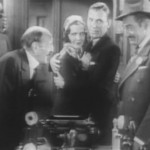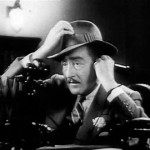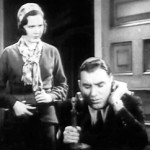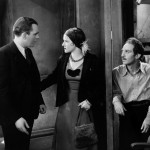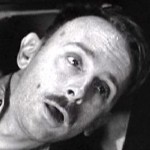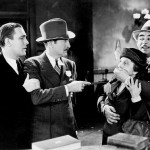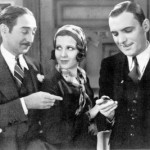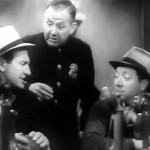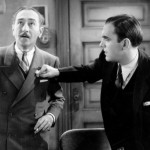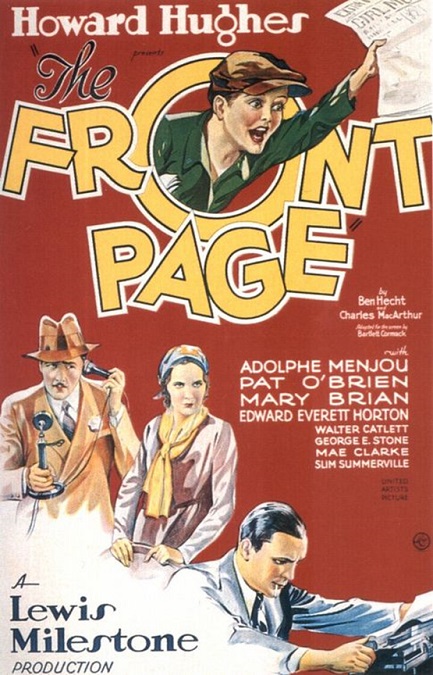

The Front Page – 1930 / 1931
This was a pretty funny movie, and like many movies of its time, it was a boundary-pusher. It was innovative in it use of camera work and had a quick and exciting pace. It was a film that inspired the movie His Girl Friday starring Cary Grant and Rosalind Russell, and a remake that re-used the title, The Front Page, in 1974 starring Jack Lemmon and Walter Matthau. A fourth version was made in 1988 called Switching Channels, starring Burt Reynolds, Kathleen Turner and Christopher Reeve. The movie itself was based on a Broadway play using the same name.
Those little facts alone are enough to tell me that the script is probably going to be a good one. This 1931 version starred Adolphe Menjou and Pat O’Brian. It is a screwball comedy that centers on O’Brian’s character, Hildy Johnson, as he attempts to leave his job as a newspaper reporter to get married to Peggy Grant, played by Mary Brian. The trouble is that he is the best at what he does. His boss, Walter Burns, played by Menjou refuses to let him go. Burns is an unscrupulous man who will resort to blackmail, manipulation, trickery, and any other means at his disposal to keep Hildy in his employ.
The press room is in a building directly across from the jail house where a man on death row is to be hanged the next morning. Sheriff Peter Hartman, played by Clarence Wilson, is a moron who allows the convict to escape with his own gun. Of course, this is the biggest news story of the century and the troupe of news men in the press room go bananas. Needless to say, comedic hijinks ensues.
There was a lot that was happening and if I had any complaint, it would be that it was too fast. Specifically, the dialogue was often delivered so fast that I couldn’t understand what was being said. I’m sure I may have missed a joke or two. And there were plenty of jokes being told. Even by today’s standards, some of the jokes were pretty darn funny. The one that made me laugh out loud was a bit of a sight gag. The crotchety Sheriff is yelling at Hildy, who is kneeling with his back to him. The Sheriff says, “I’m going to send the bill to the Post tomorrow for all the wreckings that have been committed around here the last year. How do you like that?” Hildy replies, “That’s swell. You know what else you can do?” “What?” Hildy then stands by raising his butt into the Sheriff’s face and says, “Guess!”
At another point, I was surprised when another character flips-off the mayor. Even the very last line of the film is, “The son of a ***** stole my watch!” They actually bleeped out his harsh language. I just wasn’t expecting such a word in a film from 1931.
A few of the supporting actors are worth mentioning in particular, though their roles could easily be overlooked. Frank McHugh played the part of “Mac” McCue, one of the reporters in the press room. He was cute and funny and he stood out to me as a good comedic actor. Peggy’s aged mother, Mrs. Grant, played by Effie Ellsler, was also very funny in a “Well, I Never!” kind of way. I smile just thinking about her character. In fact, the writing was so good that each of the seven or eight newspaper men in the press room had a distinct personality. Each had a funny little comedic quirk that made them all memorable. Wonderful writing!
And finally, I have to mention the innovative use of the camera. Director, Lewis Milestone, was able to create an effect that we see in modern movies all the time. He had a round table in the center of the press room. The camera would circle the table so that each of the men seated at the table would be seen at the right time to deliver his lines. It was very cleverly done. In another instance, as the news men were laughing at the Sheriff, the camera repeatedly zipped up to the ceiling and then zipped back down to the faces of the laughing men. Each time it came down, it focused on a different man, finally coming to rest on the face of the Sheriff as he became increasingly incensed. It was a simple effect, but I haven’t seen anything like it in any other movies from the early 1930s.
This was a fun movie with a fantastic plot and a wonderful and witty script. I give it two thumbs up!
